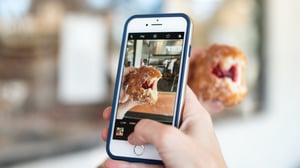
QSR Magazine: 3 Ways Fast-Food Brands Can Win on Social Media
This article was originally published on QSR Magazine.
While a bigger digital budget may get you more eyeballs, it is creativity and a genuine understanding of the customer that will drive actual engagement.
Fast food brands are no strangers to social media as a vehicle for engaging with their customers and fans. The industry has some of the highest online engagement rates, receiving comments and tweets that run into the thousands daily.
Even the big names that have comfortably dominated traditional advertising like McDonald’s and KFC have realized that online, it's a different ballgame. While a bigger digital budget may get you more eyeballs, it is creativity and a genuine understanding of the customer that will drive actual engagement.
So is all hope gone if a brand doesn’t have a naturally gifted, incredibly witty, 20-something social media rockstar employee like the viral “Wendy’s Social Media Girl?"
Not necessarily. A new study by BrandBastion analyzing over 20,000 comments posted on 11 quick-service brands’ social ads reveals a few key findings that brands can learn from when engaging on social media. Brands that can successfully put these lessons into action stand a higher chance of turning prospects into customers and customers into raving fans.
1. A little goes a long way
Despite all the negative press fast food gets for being unhealthy or having poor customer service, on the Internet, creativity still rules.
BrandBastion’s analysis found that out of all the positive comments received by QSR brands, a whopping 79.8 percent were about the ad creative itself. This indicates a chance for brands to stand out from the competition and not just rely on current menus for short-term promotions—but spark conversations with customers that will drive long-term brand loyalty.
Wendy’s, for instance, has built a brand voice that is brilliantly witty and occasionally snarky. In the past few years, they have become known for their amusing and sometimes downright ruthless “roasts” of competitor brands (usually McDonald’s). Wendy’s roaster comebacks resonate with its millennial audience because they clearly display an understanding of pop culture (bar a few unfortunate missteps) and speak the language (read: memes, gifs, and rap lyrics) of the audience.
The key takeaway is not that a brand has to be witty on social, but that it should be relevant to the audience it wants to reach—and emotions play a key role here. A study by the Institute of Practitioners in Advertising found that emotional ads are not just likeable, but they generated twice as much profit as ads based on rational content (31 percent versus 16 percent) and have a substantial positive effect on brand evaluations.
Starbucks taps into the power of emotions excellently, by creating posts designed to evoke the specific mood of each season—from warm, cozy colors and images in the fall, to bright pops of color in the summer. (Remember the #unicornfrappucino? That hashtag racked up 180,000 Instagram posts in one week!)
2. The best marketing is free
Surprisingly, people are 1.9x more likely to share the love for a brand on social media than to badmouth it. While there is always the risk of a disgruntled employee tweeting about greasy gunk in the ice cream machine, the good news is that the majority of followers on your Twitter feed are more likely to spread good things about your brand.
For instance, Taco Bell’s emoji petition, which racked up over 33,700 signatures, was a huge success. The Unicode Consortium approved the taco emoji, and shortly after, Apple included it in iOS 9.1. The publicity Taco Bell got from this was enormous, all without spending a single ad dollar.
When fans already resonate with your brand, it just takes a little nudging to create a ripple effect. A few positive reactions (or negative ones, for that matter) can quickly spread, as proven by a massive study of 689,000 users conducted in partnership with Facebook.
The study showed that “emotional states can be transferred to others via emotional contagion,” leading people to experience the same emotions without direct interaction between people. That is, seeing a friend like a post could make you happier about a brand even though you did not have a conversation with your friend about how much he liked the brand.
3. There is power in listening
Among negative comments received on quick-service brands’ social ads, 27.2 percent of them were related to the menu or food served. These comments should not be ignored, as there is much that quick-service companies can gain from real-time customer feedback. As Bill Gates puts it, “Your most unhappy customers are your greatest source of learning.”
Instead of relying just on monthly sales figures, product teams can now gain qualitative insights on how people are responding to their products. This allows them to make quicker and more informed decisions about product mix, just like how BK sneakily introduced their own spicy chicken nuggets when Wendy’s discontinued theirs—to the ire of fans. (Wendy’s decision to pull spicy nuggets from the menu even sparked a petition among fans gathering over 9,000 signatures to “bring back spicy nuggets”!)
In addition, organic feedback from customers via comments on ads are more likely to be honest and unbiased, compared to collecting customer feedback from surveys. With intelligent data mining solutions, brands can understand what’s working and what isn’t more efficiently than ever.
Read BrandBastion’s Q2 2018 analysis of over 20,000 comments posted across ads of 11 quick-service restaurant brands to gain the latest insights on the biggest issues and opportunities facing fast-food brands today.